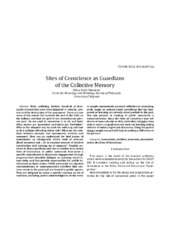Prikaz osnovnih podataka o dokumentu
Sites of Conscience as Guardians of the Collective Memory
| dc.creator | Božić Marojević, Milica | |
| dc.date.accessioned | 2023-01-17T10:40:26Z | |
| dc.date.available | 2023-01-17T10:40:26Z | |
| dc.date.issued | 2014 | |
| dc.identifier.issn | 1857-7725 | |
| dc.identifier.uri | http://reff.f.bg.ac.rs/handle/123456789/4216 | |
| dc.description.abstract | Wars, suffering, torture, hundreds of thousands of people that have been displaced or missing, poverty and the destruction of the monument. These are just some of the events that marked the end of the 20th on the Balkans and that are part of our shameful, not glorious past. Do we need to remember it at all, and how? What stories are 'permitted' and which are 'forbidden'? What is the adequate way to mark the suffering and how to do it without offending either side? What are the relations between memory and monuments, archives and museums? How can we understand the dual nature of monuments: as ideologically driven tools of memory (fixed memory) and / or as constant sources of creative construction and opening up of memory? Possible answers to these questions and also a solution is to create Sites of Conscience, or public memorials that make a specific commitment to democratic engagement through programs that stimulate dialogue on pressing social issues today and that provide opportunities for public involvement in those issues. Public memorials are physical representations or commemorative activities that concern events in the past and are located in public spaces. They are designed to evoke a specific reaction or set of reactions, including public acknowledgment of the event or people represented; personal reflection or mourning, pride, anger, or sadness about something that has happened, or learning or curiosity about periods in the past. The sole process of creating of public memorials is memorialisation. Since the Sites of Conscience may tell stories of mass atrocity or daily, individual struggles, they seek to serve as significant new tools for building lasting cultures of human rights and democracy. Using the past to engage people can and will help in making a difference in the present. | sr |
| dc.language.iso | en | sr |
| dc.publisher | MI-AN Publishing, division of Centre for Culture and Cultural Studies | sr |
| dc.relation | Creating and setting up the Site of Conscience in Brčko District is part of the project "Access to Justice: Dealing with the past and building confidence for the future", managed by the UNDP BiH. It consists of two key components related to transitional justice and increasing public confidence in the institutions responsible for the rule of law in BiH. The aim of the project is to increase availability of legal institutions and agencies in Bosnia and Herzegovina for standard users of court services and to systematically face the remaining challenges related to the victims of the 1992-95 conflict | sr |
| dc.rights | openAccess | sr |
| dc.rights.uri | https://creativecommons.org/licenses/by/4.0/ | |
| dc.source | Култура/Culture | sr |
| dc.subject | monuments | sr |
| dc.subject | archives | sr |
| dc.subject | museums | sr |
| dc.subject | memorialisation | sr |
| dc.subject | the Sites of Conscience | sr |
| dc.title | Sites of Conscience as Guardians of the Collective Memory | sr |
| dc.type | article | sr |
| dc.rights.license | BY | sr |
| dc.citation.epage | 114 | |
| dc.citation.issue | 5 | |
| dc.citation.spage | 105 | |
| dc.identifier.fulltext | http://reff.f.bg.ac.rs/bitstream/id/10208/Sites_of_Conscience_as_Guardians_of_the.pdf | |
| dc.identifier.rcub | https://hdl.handle.net/21.15107/rcub_reff_4216 | |
| dc.type.version | publishedVersion | sr |

